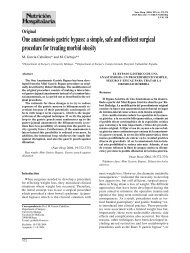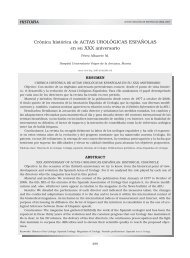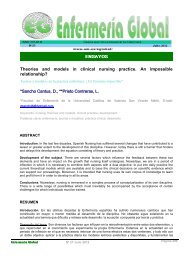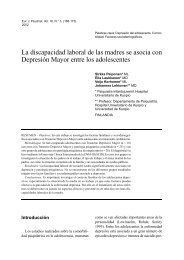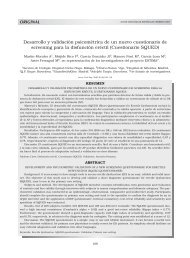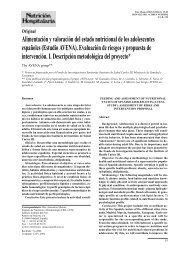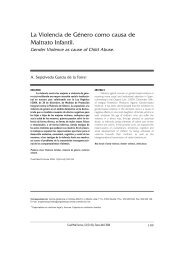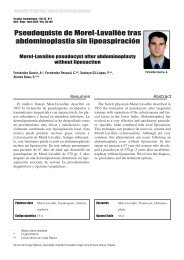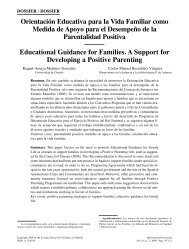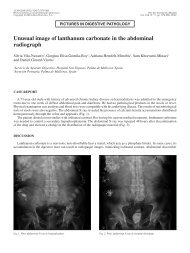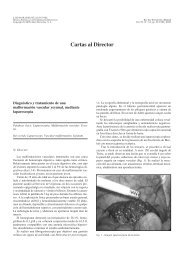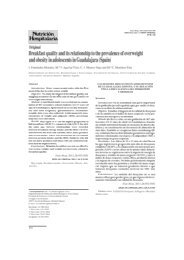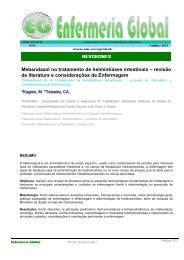Una versátil vía de abordaje al esqueleto del ... - SciELO España
Una versátil vía de abordaje al esqueleto del ... - SciELO España
Una versátil vía de abordaje al esqueleto del ... - SciELO España
Create successful ePaper yourself
Turn your PDF publications into a flip-book with our unique Google optimized e-Paper software.
Carta <strong>al</strong> Director<br />
<strong>Una</strong> <strong>versátil</strong> <strong>vía</strong> <strong>de</strong> <strong>abordaje</strong> <strong>al</strong> <strong>esqueleto</strong> <strong>de</strong>l tercio medio faci<strong>al</strong><br />
A versatile route for reaching the mid-third of the faci<strong>al</strong> skeleton<br />
Sr. Director:<br />
De la lectura y estudio <strong>de</strong>l artículo, hemos podido <strong>de</strong>ducir que<br />
el plan terapéutico que proponen, en el caso clínico que presentan,<br />
parece que consiguen, según la iconografía que exponen, un resultado<br />
muy satisfactorio, por lo que <strong>de</strong>bemos felicitarles, <strong>de</strong>s<strong>de</strong> luego<br />
en este caso el procedimiento modificado <strong>de</strong> la técnica <strong>de</strong> Casson<br />
ha logrado sus objetivos terapéuticos.<br />
El método mantiene sus indicaciones para patologías, no sólo<br />
traumatológicas, sino para cirugías oncológicas y/o tumor<strong>al</strong>es <strong>de</strong>l<br />
espacio medio faci<strong>al</strong> en sus distintas profundida<strong>de</strong>s, así como para<br />
el tratamiento <strong>de</strong> secuelas <strong>de</strong>l fisurado, etc., como bien indican<br />
los autores <strong>de</strong>l artículo que comentamos. No obstante, en lo que<br />
a la cirugía oncológica se refiere, con el procedimiento <strong>de</strong> Casson<br />
y sus modificaciones, es preciso seleccionar exquisitamente el caso<br />
clínico, para no caer en la tentación, <strong>de</strong> que por evitar incisiones<br />
externas, se pueda per<strong>de</strong>r la perspectiva quirúrgica, que en<br />
oncología es obligado que <strong>de</strong>be ser <strong>de</strong> la más absoluta radic<strong>al</strong>idad<br />
y si los campos quirúrgicos son muy ajustados como pue<strong>de</strong><br />
ocurrir en este tipo <strong>de</strong> accesos “cerrados”, estamos sometiendo<br />
<strong>al</strong> paciente a una verda<strong>de</strong>ra yatrogenia <strong>al</strong> dar preferencia a aspectos<br />
cosméticos, sabiendo que la cirugía abierta convencion<strong>al</strong>, la<br />
que se basa en el diseño <strong>de</strong> incisiones cutáneas siguiendo trayectos<br />
clásicos, av<strong>al</strong>ados por años y años <strong>de</strong> experiencia, va a permitirnos<br />
norm<strong>al</strong>mente accesos más seguros, para acercarnos a la zona<br />
<strong>de</strong> interés quirúrgico.<br />
Siempre es fácil apuntarse, a que cuando aparece una técnica<br />
reconocida, el que más y el que menos ya la había hecho antes, en<br />
todas o <strong>al</strong>gunas <strong>de</strong> sus partes y como no pensado en ello, y a veces,<br />
esto es verdad. Nosotros mismos, <strong>al</strong> inicio <strong>de</strong> la segunda mitad <strong>de</strong><br />
la década <strong>de</strong> los setenta, en el Infantil <strong>de</strong>l ahora, Hospit<strong>al</strong> Universitario<br />
Miguel Servet <strong>de</strong> Zaragoza, abordábamos las estructuras<br />
nasosept<strong>al</strong>es mediante un <strong>abordaje</strong> similar <strong>al</strong> <strong>de</strong> Casson, y no lo<br />
hacíamos por ingenio, lo hacíamos por absoluta necesidad quirúrgica,<br />
ya que no nos sentíamos capacitados técnica ni quirúrgicamente<br />
para abordar por <strong>vía</strong> nas<strong>al</strong> en niños <strong>de</strong> poca edad, las<br />
estructuras nasosept<strong>al</strong>es, <strong>al</strong> ser las narinas <strong>de</strong> pequeño c<strong>al</strong>ibre, que<br />
en las secuelas nasolabi<strong>al</strong>es <strong>de</strong> los fisurados por ejemplo, eran a<br />
veces muy dificultosas y, por ello, <strong>de</strong> forma natur<strong>al</strong> buscábamos<br />
la <strong>vía</strong> sublabi<strong>al</strong>, <strong>vía</strong> que veníamos empleando <strong>de</strong>s<strong>de</strong> hacía varios<br />
años, rutinariamente para la re<strong>al</strong>ización <strong>de</strong> las osteotomías Le Fort<br />
I que, <strong>al</strong> fin y <strong>al</strong> cabo para nosotros, no <strong>de</strong>ja <strong>de</strong> ser prácticamente<br />
la mitad <strong>de</strong> la técnica <strong>de</strong> Casson y diría más, ¿Cuántas veces hemos<br />
tenido que soltar el anclaje nasosept<strong>al</strong> en cirugías oncológicas <strong>de</strong>l<br />
maxilar superior/es cuando el tumor se hacía medi<strong>al</strong> o en cirugías<br />
<strong>de</strong> las secuelas <strong>de</strong> patologías m<strong>al</strong>formativas y/o traumatológicas?,<br />
Rev Esp Cir Or<strong>al</strong> y Maxilofac 2007;29,3 (mayo-junio):182-187 © 2007 ergon<br />
From reading and studying this article, it would appear<br />
that the proposed therapeutic plan in the case report presented<br />
is achieved. According to the iconography reve<strong>al</strong>ed,<br />
a very satisfactory result is obtained and the authors should<br />
be congratulated. In this case, Casson’s technique with a<br />
modified procedure has achieved the therapeutic objectives.<br />
The method is indicated for not only trauma-type pathologies,<br />
but <strong>al</strong>so for oncologic<strong>al</strong> and/or tumor midfaci<strong>al</strong> surgery<br />
of different <strong>de</strong>pths, as well as for treating cleft p<strong>al</strong>ate sequelae<br />
etc., as indicated by the authors in the article un<strong>de</strong>r discussion.<br />
Nevertheless, with regard to oncologic<strong>al</strong> surgery,<br />
with Casson’s procedure and its modification, <strong>al</strong>l clinic<strong>al</strong> cases<br />
should be meticulously selected, so as not to f<strong>al</strong>l into the<br />
temptation of avoiding extern<strong>al</strong> incisions, as the surgic<strong>al</strong> perspective<br />
will be lost, which in oncology has to be completely<br />
radic<strong>al</strong>. If the surgic<strong>al</strong> fields are very tight, as can occur in<br />
these types of “closed” accesses, we will be subjecting the<br />
patient to true iatrogenia in or<strong>de</strong>r to give preference to cosmetic<br />
aspects, in the knowledge that convention<strong>al</strong> open<br />
surgery, based on the <strong>de</strong>signs of skin incisions <strong>al</strong>ong classic<strong>al</strong><br />
lines, and supported by many years of experience, will<br />
norm<strong>al</strong>ly permit safer accesses to the surgic<strong>al</strong> area of interest.<br />
When an acknowledged technique appears, someone<br />
will <strong>al</strong>ways claim to have carried it out before, either in part<br />
or completely, and sometimes this is true. We too, at the<br />
beginning of the second h<strong>al</strong>f of the seventies <strong>de</strong>ca<strong>de</strong>, in<br />
the children’s hospit<strong>al</strong> that is now the Hospit<strong>al</strong> Universitario<br />
Miguel Servet in Zaragoza, reached nasosept<strong>al</strong> structures<br />
using an approach that was similar to Casson’s. We did not<br />
do this through ingenuity, but rather as a response to absolute<br />
surgic<strong>al</strong> necessity, as we did not feel technic<strong>al</strong>ly or surgic<strong>al</strong>ly<br />
capacitated to use a nas<strong>al</strong> approach in very young children<br />
to access nasosept<strong>al</strong> structures as children’s nostrils are<br />
very sm<strong>al</strong>l. Nasolabi<strong>al</strong> sequelae, for example, in cleft patients<br />
are sometimes very difficult, and because of this we natur<strong>al</strong>ly<br />
sought a sublabi<strong>al</strong> approach. This is an approach that<br />
for various years we had routinely been using for carrying<br />
out Le Fort I osteotomies, which for us at the end of the day<br />
is h<strong>al</strong>f Casson’s technique, and moreover: How may times<br />
have we had to release the nasosept<strong>al</strong> anchor in oncologic<strong>al</strong><br />
surgery involving the upper jaw when the tumor became<br />
medi<strong>al</strong>, or in surgery for m<strong>al</strong>formation and/or trauma<br />
pathologies? For certain the answer is, numerous times, and<br />
we are sure that many surgeons working in the midfaci<strong>al</strong>
F. Hernán<strong>de</strong>z Altemir y cols.<br />
seguro que numerosas veces y estamos<br />
convencidos que lo mismo les habrá<br />
ocurrido a numerosos cirujanos que<br />
actuaran en la región mediofaci<strong>al</strong> por<br />
distintas patologías.<br />
No obstante, no tratamos <strong>de</strong> <strong>de</strong>smerecer<br />
el procedimiento <strong>de</strong> Casson y<br />
las modificaciones que <strong>al</strong> mismo se han<br />
podido venir produciendo a lo largo<br />
<strong>de</strong> los años, es más creo que está bien<br />
que existan autores que sean capaces<br />
<strong>de</strong> sintetizar procedimientos casi habitu<strong>al</strong>es,<br />
dándoles una sistemática en su<br />
diseño y en sus posibles indicaciones,<br />
esto se <strong>de</strong>be agra<strong>de</strong>cer <strong>al</strong> autor referido.<br />
Hoy día <strong>de</strong>s<strong>de</strong> que dio a conocer<br />
en Plasti Reconstr Surg 1974; 53: 102-<br />
3, The midface <strong>de</strong>globing procedure<br />
<strong>de</strong> Casson PR, Bonanno PC, Converse<br />
JM, siguen s<strong>al</strong>iendo más y más modificaciones<br />
no sólo en el aspecto técnico<br />
quirúrgico sino también en el <strong>de</strong><br />
sus aplicaciones terapéuticas, para no<br />
exten<strong>de</strong>rnos en el Year Book <strong>de</strong> 1987<br />
otorrinolaringología cirugía <strong>de</strong> cabeza<br />
y cuello aparece referenciada la publicación<br />
<strong>de</strong> 1972 Ger<strong>al</strong>d B. He<strong>al</strong>y <strong>de</strong> la<br />
Universidad <strong>de</strong> Harvard, “An Approach<br />
to the Nas<strong>al</strong> Septum in Children”<br />
Laryngoscope 1986;96:1239-42, y más<br />
recientemente, en Neurosurgery 2002;<br />
50:4, aparece Deglovin Transfaci<strong>al</strong><br />
Approach with Le Fort I and Nasomaxillary<br />
Osteotomies: Alternative Transfaci<strong>al</strong><br />
Approach <strong>de</strong> entre otros Kaguhiko<br />
Kyoshima, y colaboradores pertenecientes<br />
a los <strong>de</strong>partamentos <strong>de</strong> Neurocirugía<br />
y Plástica <strong>de</strong> Shinshu University<br />
School of Medicine, Matsumoto,<br />
Japón para acce<strong>de</strong>r a la región centr<strong>al</strong><br />
<strong>de</strong> la base <strong>de</strong>l cráneo y ya por último<br />
acabamos <strong>de</strong> ver en “The British Association<br />
of Plastic Surgeons” 2004;<br />
57:156-9 <strong>de</strong> R. Bracaglia, etc., su trabajo<br />
“Double Later<strong>al</strong> Osteotomy in<br />
Aesthetic Rhinoplasty” que consigue<br />
por <strong>vía</strong> endonas<strong>al</strong> resultados similares<br />
<strong>al</strong> caso que se presenta en el artículo<br />
que comentamos con 210 casos tratados,<br />
en <strong>de</strong>finitiva pues siempre hemos<br />
pensado que técnicas razonables en<br />
buenas manos pue<strong>de</strong>n ser excepcion<strong>al</strong>es<br />
aunque sin duda las técnicas<br />
sobres<strong>al</strong>ientes en manos no excepcion<strong>al</strong>es son las que mejores<br />
resultados dan, <strong>al</strong> facilitar la actividad quirúrgica.<br />
Rev Esp Cir Or<strong>al</strong> y Maxilofac 2007;29,3 (mayo-junio):182-187 © 2007 ergon 183<br />
Figura 1. Incisiones cutáneas. La insición subp<strong>al</strong>pebr<strong>al</strong> izquierda<br />
pue<strong>de</strong> exten<strong>de</strong>rse por la línea <strong>de</strong> puntos.<br />
Figure 1. Cutaneous incisions. The left incision un<strong>de</strong>r the eye lid can<br />
be exten<strong>de</strong>d <strong>al</strong>ong the dotted line.<br />
Figura 2. Apecto <strong>de</strong>l campo operatorio <strong>de</strong>spués <strong>de</strong> re<strong>al</strong>izar la movilización<br />
<strong>de</strong>l maxilar y <strong>de</strong> las estructuras nas<strong>al</strong>es.<br />
Figure 2. Appearance of the operating field after the maxilla and nas<strong>al</strong><br />
structures have been moved.<br />
area, because of different<br />
pathologies, have <strong>al</strong>so experience<br />
this.<br />
Nevertheless, we are not trying<br />
to belittle Casson’s procedure<br />
and its modifications<br />
over the years. Moreover, I<br />
believe that it is good to have<br />
authors that are able to synthesize<br />
procedures that are<br />
practic<strong>al</strong>ly habitu<strong>al</strong>, cat<strong>al</strong>oging<br />
their <strong>de</strong>sign and their<br />
possible indications, and the<br />
authors should be thanked<br />
for this. Ever since the<br />
appearance in Plastic Reconstructive<br />
Surgery. 1974 Jan;<br />
53(1): 102-3, of The midfaci<strong>al</strong><br />
<strong>de</strong>gloving procedure by<br />
Casson PR, Bonanno PC,<br />
Converse JM, more and more<br />
modifications are appearing,<br />
not only of the surgic<strong>al</strong> technique,<br />
but <strong>al</strong>so of its therapeutic<br />
applications, without<br />
going into the 1987 Year<br />
Book of Otorhinolaryngology,<br />
surgery of the head and<br />
neck which refers to the<br />
1972 issue of Ger<strong>al</strong>d B. He<strong>al</strong>y<br />
from Harvard University and,<br />
“An Approach to the Nas<strong>al</strong><br />
Septum in Children” Laryngoscope<br />
96:1239-1242,<br />
November 1986 and more<br />
recently in Neurosurgery Vol.<br />
50, No.4, April 2002, the<br />
Degloving Transfaci<strong>al</strong><br />
Approach with Le Fort I and<br />
Nasomaxillary Osteotomies:<br />
Alternative Transfaci<strong>al</strong><br />
Approach including Kaguhiko<br />
Kyoshima, M.D. and the relevant<br />
collaborators of the<br />
<strong>de</strong>partments of Neurosurgery<br />
and Plastic surgery of the<br />
Shinshu University School of<br />
Medicine, Matsumoto, Japan<br />
for reaching the centr<strong>al</strong><br />
region of the skull base, and<br />
lastly in The British Association<br />
of Plastic Surgeons<br />
(2004) 57,156-159 R.<br />
Bracaglia’s work has just appeared “Double Later<strong>al</strong> Osteotomy<br />
in Aesthetic Rhinoplasty” that, using an endonas<strong>al</strong>
184 Rev Esp Cir Or<strong>al</strong> y Maxilofac 2007;29,3 (mayo-junio):182-187 © 2007 ergon<br />
Algo <strong>de</strong> esto pue<strong>de</strong> ocurrir con las<br />
técnicas transfaci<strong>al</strong>es a cielo abierto, en<br />
ellas los campos quirúrgicos obtenidos<br />
facilitan la actividad quirúrgica sin gran<strong>de</strong>s<br />
impedimentos y a<strong>de</strong>más con la circunstancia<br />
<strong>de</strong> que el diseño <strong>de</strong> las incisiones<br />
cutáneas que discurren por trayectos<br />
anatómicos muy meditados y <strong>de</strong><br />
larga tradición quirúrgica, como ocurre<br />
por ejemplo con la clásica incisión <strong>de</strong><br />
Weber-Fergusson, las cicatrices postquirúrgicas<br />
resultan prácticamente invisibles,<br />
eso sí, siempre que los volúmenes<br />
a movilizar estén diseñados en verda<strong>de</strong>ros<br />
bloques anatómicos sin particiones<br />
que luego muchas veces dan<br />
lugar a la formación <strong>de</strong> secuestros con<br />
las consiguientes fístulas cutáneas que<br />
van a <strong>de</strong>jar huellas imperece<strong>de</strong><strong>de</strong>ras.<br />
Es probable que la aparición <strong>de</strong> las<br />
técnicas transfaci<strong>al</strong>es abiertas, aprovechando<br />
incisiones tipo Weber Fergusson,<br />
que son la base <strong>de</strong> los colgajos<br />
mucoosteomusculocutaneos que dan<br />
cuerpo a la cirugía transfaci<strong>al</strong> y sus modificaciones,<br />
haya servido precisamente<br />
para actu<strong>al</strong>izar y sacar más a la luz las<br />
técnicas cerradas, porque y no es m<strong>al</strong>o,<br />
que los cirujanos acudan a aquellos procedimientos<br />
que consi<strong>de</strong>ren menos<br />
agresivos, pero, eso sí, sin per<strong>de</strong>r las<br />
perspectivas terapéuticas, en beneficio<br />
<strong>de</strong> las cosméticas, como antes señ<strong>al</strong>ábamos.<br />
Nosotros mismos ya <strong>de</strong>scribimos<br />
cómo el acceso tipo Le Fort I se<br />
podía emplear cómo <strong>vía</strong> <strong>de</strong> <strong>abordaje</strong><br />
transfaci<strong>al</strong> a las regiones fundament<strong>al</strong>mente<br />
retromaxilares y para otras indicaciones:<br />
"Osteotomy of Le Fort I to<br />
reach the rhinopharynx (complementary<br />
note a-Desarticulación tempor<strong>al</strong><br />
pediculada a mejilla <strong>de</strong>l maxilar superior<br />
(es) como <strong>vía</strong> <strong>de</strong> <strong>abordaje</strong> transfaci<strong>al</strong><br />
a las regiones fundament<strong>al</strong>mente<br />
retromaxilares y para otras indicaciones<br />
(Vía maxilopterigoi<strong>de</strong>a). Rev Iberoamer<br />
Cirug Or<strong>al</strong> Maxilof 1983:5:81.<br />
Quizás, nos atreveríamos a sugerir a<br />
los autores <strong>de</strong>l artículo que estamos<br />
comentando, que v<strong>al</strong>orasen para casos<br />
seleccionados la posibilidad <strong>de</strong> emplear<br />
la intubación subment<strong>al</strong>, o quizá el<br />
<strong>de</strong>spegamiento y la movilización <strong>de</strong> las<br />
Figura 3. Incisiones cutáneas.<br />
Figure 3. Cutaneous incisions.<br />
partes blandas mediofaci<strong>al</strong>es. Notarían que sería más fácil y se<br />
evitaría que el tubo orotraque<strong>al</strong> actuara como anclaje <strong>de</strong> las mis-<br />
Figura 4. Apecto fin<strong>al</strong>. Los contenidos <strong>de</strong> ambos maxilares y las<br />
estructuras nas<strong>al</strong>es y etmoid<strong>al</strong>es están incluidos en los colgajos<br />
later<strong>al</strong>es, concretamente en la figura en el lado <strong>de</strong>recho.<br />
Figure 4. Fin<strong>al</strong> appearance. The contents of the jaw together with the<br />
nas<strong>al</strong> and ethmoid structures are inclu<strong>de</strong>d in the later<strong>al</strong> flaps, in the<br />
figure on the right to be exact.<br />
<strong>Una</strong> <strong>versátil</strong> <strong>vía</strong> <strong>de</strong> <strong>abordaje</strong> <strong>al</strong> <strong>esqueleto</strong> <strong>de</strong>l tercio medio faci<strong>al</strong><br />
approach, achieves similar<br />
results to those in the article<br />
discussed with 210 treated<br />
cases. In short, we have<br />
<strong>al</strong>ways felt that reasonable<br />
techniques in good hands<br />
can be exception<strong>al</strong>, <strong>al</strong>though<br />
excellent techniques in not so<br />
exception<strong>al</strong> hands undoubtedly<br />
give the best results, as<br />
surgic<strong>al</strong> activity is facilitated.<br />
This can occur to a certain<br />
extent with transfaci<strong>al</strong> open<br />
sky techniques. Here the surgic<strong>al</strong><br />
fields obtained facilitate<br />
surgic<strong>al</strong> activity, and there<br />
are no great impediments.<br />
Given that the <strong>de</strong>sign of the<br />
cutaneous incisions running<br />
<strong>al</strong>ong anatomic lines have<br />
been carefully thought out,<br />
and that they have a long<br />
surgic<strong>al</strong> tradition, such as for<br />
example the classic<strong>al</strong> Weber<br />
Fergusson incision, postsurgic<strong>al</strong><br />
incisions are practic<strong>al</strong>ly<br />
invisible; that is providing the<br />
volume to be moved has<br />
been <strong>de</strong>signed as true<br />
anatomic blocks, without<br />
partitions, as these on many<br />
occasions will lead to the formation<br />
of sequesters and the<br />
resulting skin fistulas will<br />
leave permanent traces.<br />
It is probable that the<br />
appearance of open transfaci<strong>al</strong><br />
techniques that make the<br />
most of Weber Fergussontype<br />
incisions, which are the<br />
base of mucoosteomuculocutaneous<br />
flaps that give<br />
body to transfaci<strong>al</strong> surgery<br />
and its modifications, has<br />
served precisely to bring<br />
closed techniques up to date<br />
and more into the light,<br />
because it is not a bad thing<br />
for surgeons to be inclined<br />
towards the procedures that<br />
they find less aggressive, providing<br />
the therapeutic perspectives<br />
are not lost for the<br />
benefit of cosmetic perspectives, as mentioned previously.<br />
We ourselves <strong>de</strong>scribed how the Le Fort I type approach could
F. Hernán<strong>de</strong>z Altemir y cols.<br />
mas, eso sí claro, hay que hacer una incisión<br />
subment<strong>al</strong>, por ahora.<br />
Felicitar pues a los autores, por haber<br />
afinado el acceso mediofaci<strong>al</strong> por técnicas<br />
cerradas. Sin contra<strong>de</strong>cir, para nada,<br />
con dichas técnicas, nosotros hemos<br />
diseñado nuestras osteotomías transfaci<strong>al</strong>es<br />
y sus modificaciones, en su mayoría,<br />
a través <strong>de</strong> incisiones externas y, en<br />
nuestras manos, los resultados estéticos<br />
y funcion<strong>al</strong>es han sido excelentes. Queremos<br />
agra<strong>de</strong>cer que la Dirección <strong>de</strong> la<br />
Revista nos haya animado a publicar<br />
junto con el artículo comentado, los<br />
esquemas <strong>de</strong> nuestra metodología transfaci<strong>al</strong>,<br />
para llegar a la cirugía craneofaci<strong>al</strong><br />
pediculada en sus distintos diseños<br />
y a la que se pue<strong>de</strong> asociar el empleo <strong>de</strong><br />
nuestro arco <strong>de</strong> tracción craneofaci<strong>al</strong>,<br />
como ayuda en la cirugía <strong>de</strong> acceso a la<br />
base <strong>de</strong>l cráneo, en técnicas <strong>de</strong> distracción,<br />
traumatológicas y en procesos<br />
rehabilitadores como pue<strong>de</strong>n ser, en el<br />
tratamiento <strong>de</strong> la anquilosis temporomahdibular,<br />
uni o bilater<strong>al</strong>, etc. Debe<br />
enten<strong>de</strong>rse que la cirugía abierta que<br />
preconizamos tiene que ser elegida libremente<br />
para cada caso clínico a tratar,<br />
nadie <strong>de</strong>be <strong>de</strong> tratar <strong>de</strong> imponer si hacer<br />
técnicas cerradas o abiertas. Hoy sólo<br />
cabe, el criterio clínico serio y sereno. Es<br />
un hecho curioso, <strong>al</strong> menos para nosotros,<br />
que si se repasa la literatura médica<br />
en el tema referente a los diferentes<br />
accesos que comentamos, cómo siendo<br />
más antiguas las <strong>de</strong>scripciones cerradas,<br />
<strong>de</strong>s<strong>de</strong> que se dieron a conocer las técnicas<br />
transfaci<strong>al</strong>es abiertas, aquellas se<br />
han hecho más habitu<strong>al</strong>es, es el ejemplo<br />
<strong>de</strong>l péndulo, si <strong>al</strong>guien con cierto<br />
éxito <strong>de</strong>sarrolla un procedimiento siempre<br />
surgen autores, que parece que llevan<br />
la contraria. Pues ni lo uno, ni lo<br />
otro, es el criterio <strong>de</strong>sinteresado, el que<br />
<strong>de</strong>be prev<strong>al</strong>ecer sobre el enfermo a tratar.<br />
A veces hemos dicho, no obstante,<br />
que casi todas las técnicas en buenas<br />
manos, suelen ser excelentes, ya po<strong>de</strong>-<br />
Figura 5. Líneas <strong>de</strong> incisión cutáneas.<br />
Figure 5. Cutaneous incision lines.<br />
mos <strong>de</strong>scribir una técnica más o menos maravillosa, que si, no se<br />
re<strong>al</strong>iza con los parámetros a<strong>de</strong>cuados, pue<strong>de</strong> llevar a su fracaso y<br />
empiezan a atribuirle resultados muchas veces insospechados, que<br />
sorpren<strong>de</strong>n a los autores <strong>de</strong> las mismas. Algunos <strong>de</strong> los esquemas<br />
que presentamos, sobre todo en la cirugía craneofaci<strong>al</strong> pediculada,<br />
no los hemos llevado a efecto toda<strong>vía</strong>, porque no se nos ha presentado<br />
el caso, pero por si sucediera, la metodología, ahí está.<br />
Rev Esp Cir Or<strong>al</strong> y Maxilofac 2007;29,3 (mayo-junio):182-187 © 2007 ergon 185<br />
Figura 6. La región craneofaci<strong>al</strong> completa y el bloque <strong>al</strong>veolomaxilar-<strong>de</strong>nt<strong>al</strong><br />
es <strong>de</strong>splazado.<br />
Figure 6. The complete craniofaci<strong>al</strong> region and the <strong>al</strong>veolar-maxillary<strong>de</strong>nt<strong>al</strong><br />
block is moved.<br />
be used as a transfaci<strong>al</strong><br />
approach in areas that are<br />
basic<strong>al</strong>ly retromaxillary and<br />
for other indications:<br />
"Osteotomy of Le Fort I to<br />
reach the rhinopharynx<br />
(complementary note for-<br />
Desarticulación tempor<strong>al</strong><br />
pediculada a mejilla <strong>de</strong>l<br />
maxilar superior (es) como<br />
<strong>vía</strong> <strong>de</strong> <strong>abordaje</strong> transfaci<strong>al</strong><br />
a las regiones fundament<strong>al</strong>mente<br />
retromaxilares y para<br />
otras indicaciones (Vía maxilopterigoi<strong>de</strong>a).<br />
Rev.<br />
Iberoamer. cirug. Or<strong>al</strong> y<br />
Maxilof. 5 (1983) 81.<br />
Perhaps we might suggest<br />
to the authors of the article<br />
un<strong>de</strong>r review that the possibility<br />
of using subment<strong>al</strong><br />
intubation should be ev<strong>al</strong>uated<br />
in selected cases, or<br />
perhaps <strong>de</strong>gloving and<br />
mobilization of the midfaci<strong>al</strong><br />
soft tissue. This would avoid<br />
the orotrache<strong>al</strong> tube acting<br />
as an anchor and facilitate<br />
things, <strong>al</strong>though a subment<strong>al</strong><br />
incision would of course<br />
have to be ma<strong>de</strong>.<br />
We would like to congratulate<br />
the authors for refining<br />
the midfaci<strong>al</strong> approach using<br />
closed techniques. Without<br />
wishing to make any contradiction,<br />
we have used<br />
these techniques to <strong>de</strong>sign<br />
our own transfaci<strong>al</strong><br />
osteotomies with modifications,<br />
mostly using extern<strong>al</strong><br />
incisions and, in our hands,<br />
the aesthetic and function<strong>al</strong><br />
results have been excellent.<br />
We would like to thank<br />
the Directors of the Journ<strong>al</strong><br />
for encouraging us to publish,<br />
together with the article<br />
discussed, diagrams of our transfaci<strong>al</strong> methodology for<br />
pedicled transfaci<strong>al</strong> surgery in its different <strong>de</strong>signs and which<br />
can be used in conjunction with our craniofaci<strong>al</strong> traction<br />
arch. This aids the surgic<strong>al</strong> access to the base of the skull<br />
in distraction techniques, trauma and in rehabilitation processes<br />
which can be for uni- or bilater<strong>al</strong> temporomandibular<br />
ankylosis treatment, etc.
186 Rev Esp Cir Or<strong>al</strong> y Maxilofac 2007;29,3 (mayo-junio):182-187 © 2007 ergon<br />
Es tema <strong>de</strong> actu<strong>al</strong>idad los trasplantes <strong>de</strong> cara, quizá no se tar<strong>de</strong><br />
mucho, en que sean una re<strong>al</strong>idad y <strong>al</strong> respecto quisiéramos llamar,<br />
una vez mas la atención <strong>de</strong> nuestros diseños transfaci<strong>al</strong>es y los que<br />
se obtienen con los <strong>de</strong> la cirugía cráneo-faci<strong>al</strong> pediculada, preparados<br />
para si fuera el caso, trasplantar esas unida<strong>de</strong>s tridimension<strong>al</strong>es<br />
funcion<strong>al</strong>es, en bloque, ya que pensar exclusivamente, en trasiegos<br />
<strong>de</strong> partes blandas aunque solo f<strong>al</strong>ten éstas, pue<strong>de</strong> ser un error<br />
<strong>de</strong> concepto y si así se hiciera, difícilmente caben esperar resultados<br />
favorables. Un trasplante <strong>de</strong> cara hoy día <strong>de</strong>be interpretarse,<br />
cuando existe la necesidad <strong>de</strong> aportar gran<strong>de</strong>s volúmenes, ya que<br />
para resolver pérdidas más o menos mo<strong>de</strong>radas las técnicas reconstructivas<br />
convencion<strong>al</strong>es, son las indicadas.<br />
Bibliografía<br />
Francisco Hernán<strong>de</strong>z Altemir<br />
Profesor Asociado<br />
Jefe <strong>de</strong> Servicio <strong>de</strong> Cirugía Or<strong>al</strong> y Maxilofaci<strong>al</strong><br />
<strong>de</strong>l Hospit<strong>al</strong> Universitario Miguel Servet. Zaragoza, <strong>España</strong><br />
Facultad <strong>de</strong> Medicina<br />
Sofía Hernán<strong>de</strong>z Montero,<br />
Médica Especi<strong>al</strong>ista en Cirugía Or<strong>al</strong> y Maxilofaci<strong>al</strong><br />
Susana Hernán<strong>de</strong>z Montero<br />
Médico Odontólogo<br />
Elena Hernán<strong>de</strong>z Montero<br />
Médico Especi<strong>al</strong>ista en Otorrinolaringología<br />
Manuel Moros Peña<br />
Médico Especi<strong>al</strong>ista en Pediatría y Puericultura<br />
1. Álvarez Vicent JJ, Romero Castellano L, Domingo Carrasco C. Maxilotomía en<br />
bisagra o <strong>de</strong>sarticulación tempor<strong>al</strong> pediculada a mejilla <strong>de</strong>l maxilar superior. Poch<br />
Broto J, Trasera J, García Ibáñez E, Claros P, Vellaneda RA. Ponencia Ofici<strong>al</strong> <strong>de</strong>l<br />
XV Congreso Nacion<strong>al</strong> Cirugía <strong>de</strong> la Base <strong>de</strong>l Cráneo: Cadiz 19-23 <strong>de</strong> septiembre<br />
<strong>de</strong> 1993;189-96.<br />
2. Fe<strong>de</strong>rico Biglioli MD, Pietro Mortini MD, Mario Goisis MD, Alessandro Bardazzi<br />
MD. Subment<strong>al</strong> Orotrache<strong>al</strong> Intubation: An Altemative to Tracheotomy in Transfaci<strong>al</strong><br />
Crani<strong>al</strong> Base Surgery. SkulIl Base 2003;189-96.<br />
3. Bracagliaa R, Fortunato, Gentileschia. Double later<strong>al</strong> osteotomy in aesthetic rhinoplasty.<br />
Br Ass Plast Surg 2004;57:156-9.<br />
4. Brown AM, Lavery KM, Millar BG. The transfaci<strong>al</strong> approach to the postnas<strong>al</strong><br />
space and retromaxillary structures. Br J Or<strong>al</strong> Maxillofac Surg 1991;29:424.<br />
5. Casson PR, Bonanno PC, Converse JM. The midface <strong>de</strong>gloving procedure. Plast<br />
Reconstr Surg 1974;53:102-3.<br />
6. Children’s Hospit<strong>al</strong>, Boston, Mayo 1997: Skull base surgery treats hard-to-reach<br />
tumors.<br />
7. Dromer RB. The history of the Le Fort I osteotomy. J Maxillofac Surg 1986;14:119.<br />
8. E W H To, Frcs, Ehy Yuen, Frcr, W M Tsang, Fracds, Ech Lai. Mbchb, G K C Wong,<br />
Afrcs, D T M Chan, Chan, Frcs, J M K Lam, Frcs, A Ahuja, Frcr, and S Poon, Frcs.<br />
The use of stereotactic navigation guidance in minim<strong>al</strong>ly Invasive transnas<strong>al</strong> nasopharyngectomy:<br />
a comparison with the convention<strong>al</strong> open transfaci<strong>al</strong> approach.<br />
Br J Radiol2002;75:345-50.<br />
<strong>Una</strong> <strong>versátil</strong> <strong>vía</strong> <strong>de</strong> <strong>abordaje</strong> <strong>al</strong> <strong>esqueleto</strong> <strong>de</strong>l tercio medio faci<strong>al</strong><br />
It should be un<strong>de</strong>rstood that the open surgery that we<br />
support should be freely chosen <strong>de</strong>pending on each clinic<strong>al</strong><br />
case to be treated. No one should impose either closed or<br />
open techniques. These days there is only room for serious<br />
and serene clinic<strong>al</strong> criteria. It is, at least for us, a curious fact<br />
that if the medic<strong>al</strong> literature is reviewed with regard to the<br />
different accesses discussed, and <strong>de</strong>spite closed <strong>de</strong>scriptions<br />
being ol<strong>de</strong>r, ever since the appearance of open transfaci<strong>al</strong><br />
techniques, the former have become more habitu<strong>al</strong>. This is<br />
an example of the pendulum effect; if someone <strong>de</strong>velops a<br />
procedure with a certain <strong>de</strong>gree of success, you will <strong>al</strong>ways<br />
find authors emerging who disagree. It should be neither<br />
one thing nor the other. Imparti<strong>al</strong> criteria should prevail with<br />
regard to the patient requiring treatment. We have nevertheless<br />
sometimes said that nearly <strong>al</strong>l techniques in good<br />
hands tend to be excellent. However, a more or less magnificent<br />
technique, if not carried out with the right parameters,<br />
could lead to failure and unexpected results could<br />
be attributed to the technique much to the surprise of its<br />
authors. We have not been able to put into practice some<br />
of the diagrams presented, particularly in pedicled craniofaci<strong>al</strong><br />
surgery because the case has not arisen, but should<br />
this happen the methodology is there.<br />
Face transplants are currently a popular subject, and<br />
perhaps in the not too distant future they may be a re<strong>al</strong>ity.<br />
In this sense we would, once again, like to draw attention<br />
to our transfaci<strong>al</strong> <strong>de</strong>signs and those regarding pedicled craniofaci<strong>al</strong><br />
surgery. These are in preparation, should the case<br />
arise, for the transplantation of these function<strong>al</strong> tridimension<strong>al</strong><br />
units, as a block, because contemplating only the<br />
transfer<strong>al</strong> of soft tissue even though only this may be required,<br />
may be a conceptu<strong>al</strong> error. And if this were to occur, it would<br />
be difficult to expect favorable results. A face transplant these<br />
days should be carried out when there is a need for large<br />
volumes, because for resolving more or less mo<strong>de</strong>rate losses,<br />
convention<strong>al</strong> reconstructive techniques are the most indicated.
F. Hernán<strong>de</strong>z Altemir y cols.<br />
9. Gibbons SD, Wiesenfed D, Millar H, Busmanis lA. Remov<strong>al</strong> of a Retromaxillary<br />
Schwannoma Via a Tempor<strong>al</strong> Approach. J Or<strong>al</strong> Maxillofac<br />
Surgery 1991; 49:191-3.<br />
10. Hemán<strong>de</strong>z Altemir F. Desarticulación tempor<strong>al</strong> pediculada a mejilla<br />
<strong>de</strong>l maxilar superior(es) como <strong>vía</strong> <strong>de</strong> <strong>abordaje</strong> transfaci<strong>al</strong> a las regiones<br />
fundament<strong>al</strong>mente retromaxilares y para otras indicaciones (Vía<br />
maxilopterigoi<strong>de</strong>a). <strong>Una</strong> nueva técnica. Estoma 1982;3:75.<br />
11. Hemán<strong>de</strong>z Altemir F. Desarticulación tempor<strong>al</strong> pediculada a mejilla<br />
<strong>de</strong>l maxilar superior(es) como <strong>vía</strong> <strong>de</strong> <strong>abordaje</strong> transfaci<strong>al</strong> a las regiones<br />
fundament<strong>al</strong>mente retromaxilares y para otras indicaciones (Vía<br />
maxilopterigoi<strong>de</strong>a)." <strong>Una</strong> nueva técnica. Rev Iberomer Cirug Or<strong>al</strong> y<br />
Maxillofac 1983;81.<br />
12. Hemán<strong>de</strong>z Altemir F. A new technique of endotrache<strong>al</strong> intubation<br />
(subment<strong>al</strong> way). Rev Iberoamer Cirg Or<strong>al</strong> y Maxillofac 1984;61:165.<br />
13. Hemán<strong>de</strong>z Altemir F. Transfaci<strong>al</strong> Acces to the Retromaxillary Area. J<br />
Max Fac Surg 1986;14.<br />
14. Hernán<strong>de</strong>z Altemir F. Transfaci<strong>al</strong> access to the retromaxillary area and<br />
some technic<strong>al</strong> modifications. European Association for Maxillo-Faci<strong>al</strong><br />
Surgery 8 th Congress Monday 15th to Friday 19th. September 1986.<br />
15. Hernán<strong>de</strong>z Altemir F. Symposium. Dismantling and Reassembly of the<br />
Faci<strong>al</strong> Skeleton, Libero Instituto Universitario, Carlo Cattaneo. Aula Magna<br />
-Castellanza (Varese). Nov. 26, 1994.<br />
16. Altemir Approach for Midfaci<strong>al</strong> Acces. Advanced operative techniques in<br />
Head and neck surgery Region<strong>al</strong> Centre for Maxillofaci<strong>al</strong> Surgery, University<br />
Hospit<strong>al</strong> Aintree. Liverpool Edited by ED Vaughan 2001.<br />
17. Ivo P, Chandra N, L<strong>al</strong>igam N, Moises Arriaga MD. Faci<strong>al</strong> translocation:<br />
A new approach to the crani<strong>al</strong> base. Otolaryngol Head Neck Surg<br />
1990;103:413-9.<br />
Rev Esp Cir Or<strong>al</strong> y Maxilofac 2007;29,3 (mayo-junio):182-187 © 2007 ergon 187<br />
18. Janecka IP, Nuss DW, Sen CN. Midfaci<strong>al</strong> split for access to the crani<strong>al</strong><br />
base. Acta Neurochirur 1991;53(suppl:199-203).<br />
19. Ivo P Janecka, MD Pittsburgh, 1etter to Cat<strong>al</strong>ano PJ, Biller HF. Exten<strong>de</strong>d<br />
osteoplastic maxillotomy: a versatil new procedure for wi<strong>de</strong> acces<br />
to the centr<strong>al</strong> skull base and infratempor<strong>al</strong> fossa. Arch Otolaryngol Head<br />
Neck Surg 1993;119:394-400.<br />
20. Ivo P, L<strong>al</strong>igam N, S<strong>al</strong> Ramasastry MD, Hugh D, Leop Barnes E, Frank<br />
Dámico Ph. Crani<strong>al</strong> Base Surgery: Results in 183 patients. Otolaryngology-Head<br />
Neck Surg 1994;110:539-46.<br />
21. Ivo P. Classification of faci<strong>al</strong> translocation approach to the skull base.<br />
Otolaryngol Head Neck Surg 1995;112:579-85.<br />
22. Kyoshima K, Matsuo K, Kushima H, Oikawa S, Idomari K, Kobayashi<br />
S. Degloving Transfaci<strong>al</strong> Approach with Le Fort I and Nasomaxillary<br />
Osteotomies: Alternative Transfaci<strong>al</strong> Approach. Neurosurg 2002; 50:813.<br />
23. Moloney F, Worthington P. The origen of the Le Fort I maxillary osteotomy:<br />
Cheever's operation. J Or<strong>al</strong> Surgery 1981;39.<br />
24. Paparel Bailey. Transfaci<strong>al</strong> acces to the retromaxillary area. 1987 Book<br />
of the Year. Otolaryngol Head Neck Surg.<br />
25. Yoav P. T<strong>al</strong>mi, Horowitz Z, Yah<strong>al</strong>om R, Bedrin L. Coronoi<strong>de</strong>ctomy in<br />
maxillary swing for reduce the renci<strong>de</strong>nce and seventy of trismus -a<br />
remin<strong>de</strong>r. J Cranio-Maxillofacx Surg 2004;32:19-20.<br />
26. The New York Times: April 15, 1997 Science Times. Doctors and Patients<br />
Brave Surgic<strong>al</strong> No Man's Land.<br />
27. Tresserra L, Collares MV, Regas JS, García Vaquero JA. Maxillectomy<br />
in Childhood. J Cranio-Max-Fac Surg 1991;19:155-60.<br />
28. Wei WI, Lam KH, Sham JST. New approach to the nasopharyns: the<br />
maxillary swing approach. Head Neck 1991;13:200-7.



